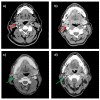Frequency and Consequences of Cervical Lymph Node Overstaging in Head and Neck Carcinoma
- PMID: 35741189
- PMCID: PMC9221862
- DOI: 10.3390/diagnostics12061377
Frequency and Consequences of Cervical Lymph Node Overstaging in Head and Neck Carcinoma
Abstract
Clinical lymph node staging in head and neck carcinoma (HNC) is fraught with uncertainties. Established clinical algorithms are available for the problem of occult cervical metastases. Much less is known about clinical lymph node overstaging. We identified HNC patients clinically classified as lymph node positive (cN+), in whom surgical neck dissection (ND) specimens were histopathologically negative (pN0) and in addition the subgroup, in whom an originally planned postoperative radiotherapy (PORT) was omitted. We compared these patients with surgically treated patients with clinically and histopathologically negative neck (cN0/pN0), who had received selective ND. Using a fuzzy matching algorithm, we identified patients with closely similar patient and disease characteristics, who had received primary definitive radiotherapy (RT) with or without systemic therapy (RT ± ST). Of the 980 patients with HNC, 292 received a ND as part of primary treatment. In 128/292 patients with cN0 neck, ND was elective, and in 164 patients with clinically positive neck (cN+), ND was therapeutic. In 43/164 cN+ patients, ND was histopathologically negative (cN+/pN-). In 24 of these, initially planned PORT was omitted. Overall, survival did not differ from the cN0/pN0 and primary RT ± ST control groups. However, more RT ± ST patients had functional problems with nutrition (p = 0.002). Based on these data, it can be estimated that lymph node overstaging is 26% (95% CI: 20% to 34%). In 15% (95% CI: 10% to 21%) of surgically treated cN+ HNC patients, treatment can be de-escalated without the affection of survival.
Keywords: computed tomography; head and neck neoplasm; neck dissection; tumor staging.
Conflict of interest statement
The authors declare no conflict of interest.
Figures



Similar articles
-
Patterns of lymph node metastasis of parotid cancer.Auris Nasus Larynx. 2016 Aug;43(4):446-50. doi: 10.1016/j.anl.2015.11.002. Epub 2015 Dec 4. Auris Nasus Larynx. 2016. PMID: 26656731
-
Multicentric prospective study on the prevalence of sublevel IIb metastases in head and neck cancer.Arch Otolaryngol Head Neck Surg. 2007 Sep;133(9):897-903. doi: 10.1001/archotol.133.9.897. Arch Otolaryngol Head Neck Surg. 2007. PMID: 17875856
-
Delayed lymph node metastases after elective neck dissection in patients with oral and oropharyngeal cancer and pN0 neck.Am J Otolaryngol. 2012 Sep-Oct;33(5):505-9. doi: 10.1016/j.amjoto.2011.11.005. Epub 2012 Jan 2. Am J Otolaryngol. 2012. PMID: 22218151
-
Occult lymph node metastasis in the contralateral neck of oropharyngeal squamous cell carcinoma: a meta-analysis and literature review.Eur Arch Otorhinolaryngol. 2022 Apr;279(4):2157-2166. doi: 10.1007/s00405-021-07230-5. Epub 2022 Jan 18. Eur Arch Otorhinolaryngol. 2022. PMID: 35041065 Review.
-
Malignant tumours of the parotid gland: management of the neck (including the clinically negative neck) and a literature review.Br J Oral Maxillofac Surg. 2021 Jul;59(6):665-671. doi: 10.1016/j.bjoms.2020.08.026. Epub 2020 Aug 27. Br J Oral Maxillofac Surg. 2021. PMID: 33952405 Review.
References
-
- Bernier J., Domenge C., Ozsahin M., Matuszewska K., Lefebvre J.L., Greiner R.H., Giralt J., Maingon P., Rolland F., Bolla M., et al. Postoperative irradiation with or without concomitant chemotherapy for locally advanced head and neck cancer. N. Engl. J. Med. 2004;350:1945–1952. doi: 10.1056/NEJMoa032641. - DOI - PubMed
-
- Harrison L.B., Sessions R.B., Kies M.S. Head and Neck Cancer: A Multidisciplinary Approach. 4th ed. Wolters Kluwer Health/Lippincott Williams & Wilkins; Philadelphia, PA, USA: 2014.
LinkOut - more resources
Full Text Sources

